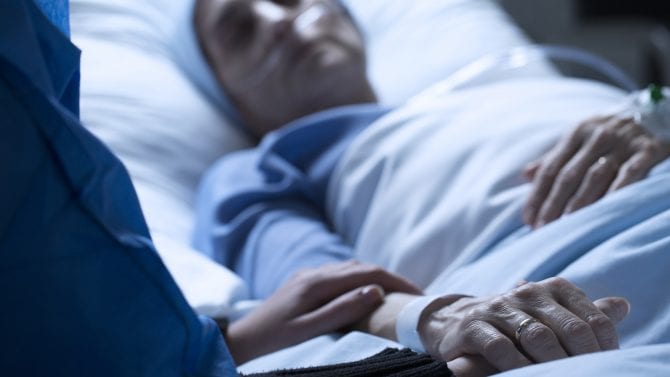Fact: End Of Life Hydration Benefit Or Burden. Few treatment decisions are more difficult for loved ones and families to make than the use of artificial hydration and nutrition in the seriously or terminally ill person:
“Should nutrition be administered intravenously if my wife’s gut isn’t functioning properly?”
“Should my father be given intravenous fluids if he stops drinking and then becomes dehydrated?”
“Should my mother have a feeding tube inserted if she can’t swallow without choking?”
Family members obsess over these questions, particularly if they are not given clarity about the efficacy or lack thereof of numerous available treatments and the burdens, side effects, and complications that each treatment can impose on the patient and caregivers.
This article will describe and define each treatment in simple terms, including when each treatment may be helpful and when each treatment is unlikely to be useful, as well as the known burdens, side effects, and problems of each treatment.
Contents
- 1 Artificial nutrition & hydration in all forms
- 2 What exactly do you mean by “artificial nutrition and hydration”?
- 3 End Of Life Hydration Benefit Or Burden? What is a person who receives “artificial nutrition and hydration” given?
- 4 What is known about the complications and side effects of artificial nourishment and hydration?
- 5 In conclusion
Artificial nutrition & hydration in all forms
Before answering the question End Of Life Hydration Benefit Or Burden, let us explain to you what artificial nutrition and hydration mean.
Require the patient to go through uncomfortable, and even at times painful, procedures for the treatment to begin;
There are known side effects as well as potential complications, such as serious infections, nausea/vomiting, diarrhea, fluid overload, electrolyte but also mineral imbalances, or even death.
Have indications (treatment use for patients who have similar conditions has typically been more positive than negative);
Have contraindications (the treatment has been shown to be more harmful than beneficial in patients with similar conditions);
They bear little resemblance to a person sitting with family as well as socializing while enjoying a delicious meal.
What exactly do you mean by “artificial nutrition and hydration”?

Artificial nutrition and/or hydration is a care intervention in which fluids and/or nutrition are delivered by means other than a person putting something in his/her mouth as well as swallowing it.
There are several types of artificial hydration and nutrition which are broadly classified into two main categories:
- Enteral nutrition and/or fluids are administered via a tube inserted into the gastrointestinal tract. The tube can be passed through the throat and nose into the esophagus and then into the stomach or small intestine (nasogastric tube), or it can be surgical intervention placed directly into the abdomen (gastrostomy tube) or intestine (jejunostomy tube) through the abdominal wall.
- Parenteral nutrition and/or fluids are administered through a catheter (a very small tube inserted into a vein in the body). The catheter may be inserted into a “peripheral vein” (usually in the lower arm) or a “central vein” (one of the larger veins in the body, closer to the heart).
End Of Life Hydration Benefit Or Burden? What is a person who receives “artificial nutrition and hydration” given?
So, End Of Life Hydration Benefit Or Burden? Here are the benefits of it. The nutrients and/or fluids given vary greatly depending on the type of artificial hydration and nutrition used, as well as the needs of each patient:
Water, special liquid diets, other liquids, or even pureed foods can be delivered through enteral feeding tubes.
Parenteral nutrition can be partial (only supplying some of the nutrients required by the body) as well as total.
Parenteral fluids are typically salt and sugar water solutions with the addition of other substances such as minerals on occasion.
These treatments were originally intended to be used only temporarily, till a person with a repairable problem managed to regain the ability to eat and drink normally. Their application has grown in both popularity and duration.
Recently, the scientific community has examined the use of artificial hydration and nutrition to determine whether there is sufficient evidence that these treatment options are beneficial. There have been some unexpected discoveries! Myths about the effectiveness of artificial hydration and nutrition are being debunked, especially as they have been used for people with incurable diseases, people with neurologic or brain disorders, and the frail elderly.
See more information about What Vitamins Are Good For Teeth.
What is known about the complications and side effects of artificial nourishment and hydration?

Answer the question: End Of Life Hydration Benefit Or Burden? The type of artificial hydration and nutrition used affects the complications and side effects:
TPN and central catheters can result in infection at the catheter site and in the catheter itself, in addition to sepsis (a generalized life-threatening infection). Pneumothorax (lung collapse) can occur while inserting the catheter. Thrombosis (vein clots) can occur, causing swelling. These clots can sometimes move to other parts of the body, such as the brain or lungs, and can be fatal. Cardiac arrhythmias (irregular heartbeats) and electrolyte disturbances including low sodium, potassium, or blood sugar can occur.
Choking as well as extreme discomfort can occur during and after the placement of a nasogastric tube. It can become misplaced in the trachea during insertion and cause pneumonia. The tube can cause erosions as well as abrasions in the nasal passages, esophagus, and stomach, as well as acute and chronic bleeding. When an NG tube is in place, there is a risk of aspiration pneumonia. If an individual is confused, restraints may be required to prevent him or her from trying to pull the tube out. To name a few, this can result in psychic distress but also increased agitation as well as pneumonia due to immobility, anxiety, skin breakdown due to immobility, and injury from restraints.
Anesthesia is required for the placement of a gastrostomy tube, and there are risks involved with the administration of anesthesia. There is also a risk of abdominal wall infection and peritonitis. Gastrointestinal bleeding, bowel blockage, or bowel perforation may occur. Diarrhea caused by the feeding formula is quite common. Aspiration pneumonia is another common complication.
Intravenous fluids necessitate the use of IV tubing, which can be painful to insert. It is possible to develop a localized infection as well as cellulitis (a more serious skin infection that can spread). Thrombophlebitis (vein clotting) can occur, causing swelling and discomfort. Fluid overload may occur, resulting in swelling of the legs, arms, and body. Electrolyte imbalances are common, such as low sodium or potassium.
Discover 3 ways How to Fall Asleep Fast right here.
In conclusion
Artificial hydration and nutrition is a medical treatment with many side effects and complications associated with their use. Therefore, Is End Of Life Hydration Benefit Or Burden? Decisions about its use must be based on a dispassionate examination of what, if any, benefits will occur, and which side effects, as well as burdens, are likely to occur, and what treatment’s goals are for individuals and families.
See more information about the health benefits of dry fruit.

